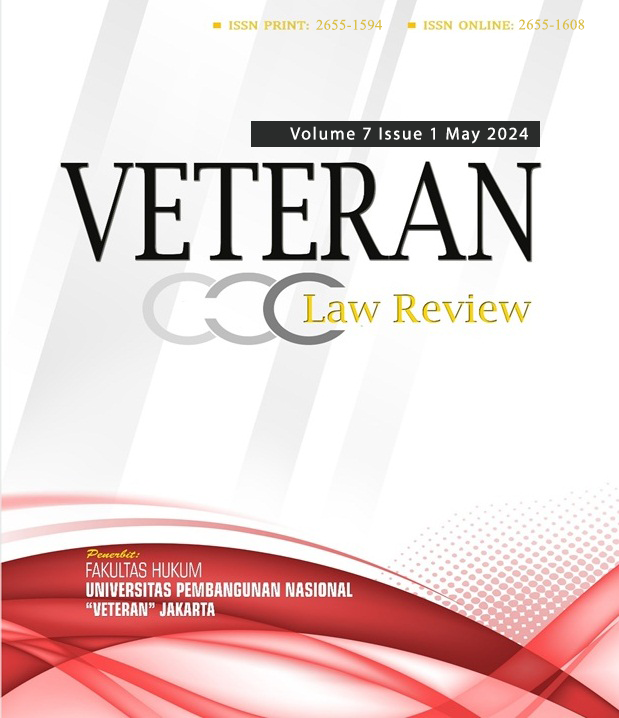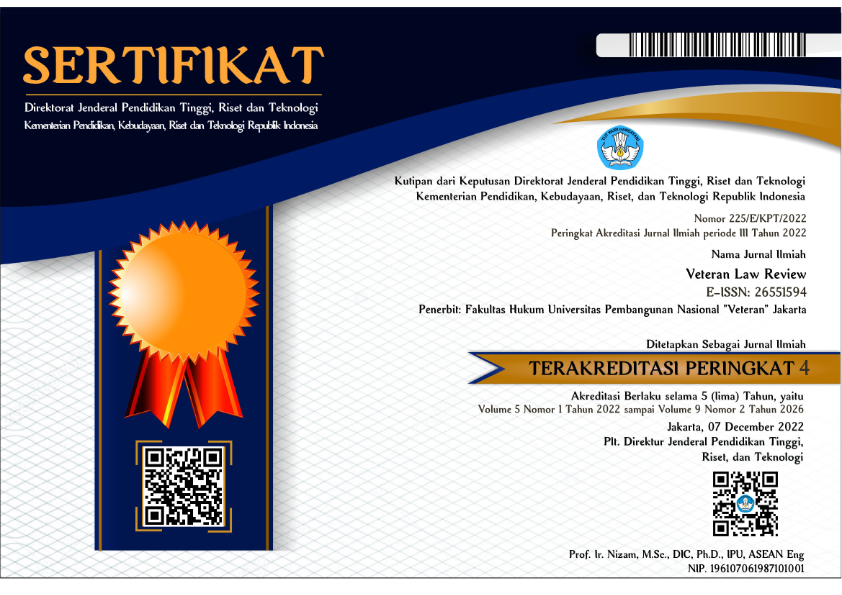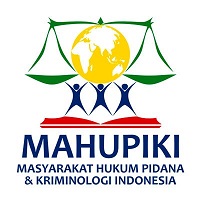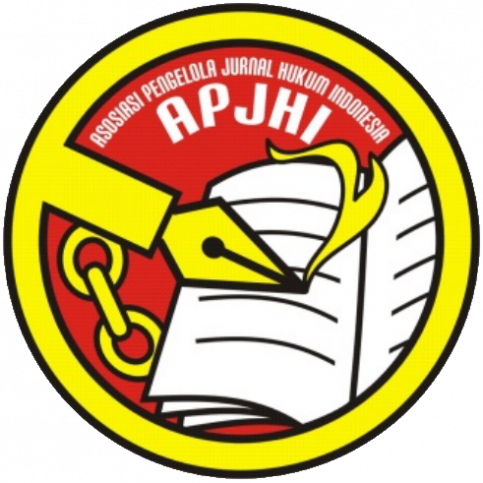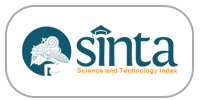The Role of Labour Inspector in Preventing and Overcoming Child Labour Exploitation: A Critical Review
DOI:
https://doi.org/10.35586/velrev.v7i1.7869Keywords:
Child Labour, Labour Inspector, Human RightsAbstract
The right to decent work is a fundamental human right that applies to everyone without exception, including children. This is clearly stated in several Indonesian laws, such as Law No. 39 of 1999 concerning Human Rights, Law No. 13 of 2003 concerning Manpower, and Law No. 23 of 2002 in conjunction with Law No. 35 of 2014 concerning Children. Although many legal provisions aim to protect children from exploitation in the workplace, the situation still needs improvement due to a lack of effective implementation. The labour inspectorate is responsible for enforcing these laws, but the number of inspectors is limited, and their authority often needs to be fully implemented. As a result, many children are still working in dangerous or exploitative conditions, which is unacceptable. Therefore, it is crucial to strengthen the labour inspectorate's role by increasing the number of implementing personnel and improving their authority's effectiveness to ensure child labours’ protection.
Downloads
References
Book:
Casale, Giuseppe et al. (2012). Pengawasan Ketenagakerjaan: Apa dan Bagaimana. Geneva: ILO.
Labour, International Programme on the Ellimination of Child. (2002). Menanggulangi Pekerja Anak: Panduan untuk Pengawas Ketenagakerjaan. Geneva: ILO.
Organization, International Labour. (2022). Pedoman Mengenai Prinsip Umum Pengawasan Ketenagakerjaan. Jakarta: ILO.
Statistik, Badan Pusat. (2022). Booklet Pekerja Anak di Indonesia 2022 Sebelum dan Semasa Pandemi Covid-19. Jakarta: BPS RI.
Suparmiyati, Eko, et al. (2016). Laporan Analisis Evaluasi Hukum dalam Rangka Melindungi Kelompok Rentan Fokus Kesejahteraan Anak. Jakarta: Badan Pembangunan Hukum Nasional.
Journal:
Faridah, S., & Afiyani, L. (2019). Child Labour Issues and Relations with Human Rights. Lex Scientia Law Review, 3(2), 163-176. https://doi.org/10.15294/lesrev.v3i2.35398
Nuraeni, Yeni et al. (2022). Menciptakan Layanan Pengawasan Ketenagakerjaan Secara Profesional, Modern, dan Bermartabat Berbasis Teknologi Digital. Jurnal Teknologi Informasi dan Ilmu Komputer, 9(1), 181-190. https://doi.org/10.25126/jtiik.201743299
Tannasa, Yenny Krisnny. (2016). Peranan Pegawai Pengawas Ketenagakerjaan Dalam Menangani Masalah Ketenagakerjaan Menurut Undang – Undang Nomor 13 Tahun 2003 Tentang Ketenagakerjaan. Lex Administratum, 4(2), 154-164.
Website:
International Labour Organization & Kementerian Ketenagakerjaan RI. (2011). Pengawasan Ketenagakerjaan: Kondisi Umum. https://webapps.ilo.org/wcmsp5/groups/public/---asia/---ro-bangkok/---ilo-jakarta/documents/publication/wcms_166444.pdf. Accessed on April 20th 2024.
International Labour Organization & Kementerian Ketenagakerjaan RI. (2020). Factsheet on Labour Inspection in Indonesia. https://webapps.ilo.org/wcmsp5/groups/public/---asia/---ro-bangkok/---ilo-jakarta/documents/publication/wcms_549704.pdf. Accessed on April 20th 2024.
International Labour Organization. (2021). Child Labour Rises to 160 Million – First Increase in Two Decades. https://www.ilo.org/global/about-the-ilo/newsroom/news/WCMS_800090/lang--en/index.htm. Accessed on April 14th 2024.
Kementerian Ketenagakerjaan RI. (2022). https://wajiblapor.kemnaker.go.id/. Accessed on April 20th 2024.
Komisi Perlindungan Anak Indonesia. (2020). Bagaimana Perlindungan Khusus Pekerja Anak Di Masa Pandemi. https://www.kpai.go.id/publikasi/tinjauan/press-release-kpai. Accessed on April 14th 2024.
Komisi Perlindungan Anak Indonesia. (2022), Sinergi Mewujudkan Indonesia Bebas Pekerja Anak dan Penghapusan Pekerjaan Terburuk Bagi Anak (PBPTA). https://www.kpai.go.id/publikasi/sinergi-mewujudkan-indonesia-bebas-pekerja-anak-dan-penghapusan-pekerjaan-terburuk-bagi-anak-pbpta. Accessed on April 20th 2024.
Nabilah Muhamad. (2024). Ada 1 Juta Pekerja Anak di Indonesia pada 2023, Ini Rentang Usianya. https://databoks.katadata.co.id/datapublish/2024/05/06/ada-1-juta-pekerja-anak-di-indonesia-pada-2023-ini-rentang-usianya. Accessed on April 21st 2024.
Ombudsman. (2021). Ombudsman dan Paradoks Pengawasan Ketenagakerjaan. https://ombudsman.go.id/pengumuman/r/artikel--ombudsman-dan-paradoks-pengawasan-ketenagakerjaan. Accessed on April 20th 2024.
Save the Children. (2021). Lebih dari 800.000 Anak Indonesia Terjebak dalam Bentuk Pekerjaan Terburuk bagi Anak. https://savethechildren.or.id/artikel/lebih-dari-800-000-anak-indonesia-terjebak-dalam-bentuk-pekerjaan-terburuk-bagi-anak. Accessed on April 21st 2024.
Sri Wibisono. (2023). Waspada Praktik Eksploitasi Anak di Perkebunan Kelapa Sawit. https://kaltim.idntimes.com/news/kaltim/sri-wibisono/waspada-praktik-eksploitasi-anak-di-perkebunan-kelapa-sawit?page=all. Accessed on April 14th 2024.
Regulation:
Undang – Undang Nomor 39 Tahun 1999 Tentang Hak Asasi Manusia. Lembaran Negara Tahun 1999 Nomor 165. Tambahan Lembaran Negara Nomor 3886.
Undang-Undang Nomor 23 Tahun 2002 tentang Perlindungan Anak. Lembaran Negara Republik Indonesia Tahun 2002 Nomor 109. Tambahan Lembaran Negara Republik Indonesia Nomor 4235
Undang – Undang Nomor 13 Tahun 2003 Tentang Ketenagakerjaan. Lembaran Negara Tahun 2003 Nomor 39. Tambahan Lembaran Negara Nomor 4279.
Undang – Undang Nomor 35 Tahun 2014 Tentang Perubahan Atas Undang – Undang Nomor 23 Tahun 2002 Tentang Perlindungan Anak. Lembaran Negara Tahun 2014 Nomor 297. Tambahan Lembaran Negara Nomor 5606.
Peraturan Presiden Nomor 21 Tahun 2010 Tentang Pengawasan Ketenagakerjaan.
Peraturan Menteri Ketenagakerjaan Nomor 33 Tahun 2016 Tentang Tata Cara Pengawasan Ketenagakerjaan.
Peraturan Menteri Ketenagakerjaan Nomor 1 Tahun 2020 Tentang Perubahan Atas Peraturan Menteri Ketenagakerjaan Nomr 33 Tahun 2016 Tentang Tata Cara Pengawasan Ketenagakerjaan.
Downloads
Published
How to Cite
Issue
Section
License
Copyright (c) 2024 Veteran Law Review

This work is licensed under a Creative Commons Attribution-ShareAlike 4.0 International License.
Copyright (c) 2022 Veteran Law Review Journal
Veteran Law Review © 2022 by Faculty of Law Universitas Pembangunan Nasional "Veteran" Jakarta is licensed under Creative Commons Attribution 4.0 International

1. License
The non-commercial use of the article will be governed by the Creative Commons Attribution license as currently displayed on Creative Commons Attribution 4.0 International.
2. Author(s)' Warranties
The author warrants that the article is original, written by the stated author(s), has not been published before, contains no unlawful statements, does not infringe the rights of others, is subject to copyright that is vested exclusively in the author, and free of any third party rights, and that any necessary written permissions to quote from other sources have been obtained by the author(s).
3. User/Public Rights
VELREV's spirit is to disseminate articles published are as free as possible. Under the Creative Commons Attribution-ShareAlike 4.0 International License. VELREV permits users to copy, distribute, display, and perform the work for non-commercial purposes only. Users will also need to attribute authors and VELREV to distributing works in the journal and other media of publications.
4. Rights of Authors
Authors retain all their rights to the published works, such as (but not limited to) the following rights;
- Reproduce the work
- Prepare derivative works based upon the work
- Distribute copies of the work
- Perform the work publicly
- Display the work publicly
- Copyright and other proprietary rights relating to the article, such as patent rights,
- The right to self-archive the article,
- The right to enter into separate, additional contractual arrangements for the non-exclusive distribution of the article's published version (e.g., post it to an institutional repository or publish it in a book), with an acknowledgement of its initial publication in this journal (Veteran Law Review).
5. Co-Authorship
If the article was jointly prepared by more than one author, any author submitting the manuscript warrants that he/she has been authorized by all co-authors to be agreed on this copyright and license notice (agreement) on their behalf, and agrees to inform his/her co-authors of the terms of this policy. VELREV will not be held liable for anything that may arise due to the author's internal dispute. VELREV will only communicate with the corresponding author.
6. Royalties
Being an open accessed journal and disseminating articles for free under the Creative Commons license term mentioned, author(s) are aware that VELREV entitles the author(s) to no royalties or other fees.
7. Miscellaneous
VELREV will publish the article (or have it published) in the journal if the article’s editorial process is successfully completed. JOSI's editors may modify the article to a style of punctuation, spelling, capitalization, referencing, and usage that deems appropriate. The author acknowledges that the article may be published so that it will be publicly accessible and such access will be free of charge for the readers as mentioned in point 3.

